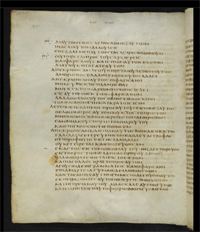Olsen Park Church of Christ |
 |

|
Is John 7:53-8:11 Inspired?
Some modern translations place notes in the text at the end of John chapter seven which read something like this one found in the English Standard Version—“[The earliest manuscripts do not include 7:53-8:11].” If this is true why do most Bibles include this text? Noted Greek Scholar Daniel B. Wallace in an article entitled “My Favorite Passage that’s Not in the Bible” has even gone so far as to argue that it is time to “own up to our tradition of timidity” calling on “translators to remove this text from the Gospel of John and relegate it to the footnotes” (Bible.org). Is Wallace correct? Should this passage be removed from biblical translations, or is it indeed part of the inspired record? It is true that many of the early Greek manuscripts that have survived do not include this passage and a gap exists between the main manuscript that does and later copies. However, there is also evidence that indicates that this passage was present in early manuscripts that have not survived and was understood from the very beginning to have been a part of the inspired record. Because of this, more accurately such notes should read, “the earliest surviving manuscripts do not include John 7:53-8:11.” It is clear that very early on a textual issue arose regarding this passage, which likely explains its exclusion from some manuscripts. The 2nd-3rd century church writer Origen claimed that by his time, “much disagreement of manuscripts” had already arisen “either from the laziness of some scribes, the boldness of some wretched persons, from the thoughtlessness of the corrector of the things written, or even from those determining things for themselves by either making additions or taking things away” (Commentary on Matthew 15.14, Pope). The 4th-5th century commentator Augustine claimed that this had been done to the account of Jesus’ forgiveness of the woman caught in adultery. Addressing the Lord’s willingness to forgive the woman, he wrote: But this apparently frightens the unbelieving senses, so that some of little faith, or rather enemies of the true faith, (I believe, fearing that by the forgiveness of the adulteress the Lord has given immunity to their wives to sin), remove it out of their manuscripts, as if He gives permission to sin who said: “From now on, sin no more...” (On Adulterous Marriages 2.7, Pope). Is there evidence to support Augustine’s claim that some had removed John 7:53-8:11 out of biblical manuscripts for fear that it might encourage sin? Codex Bezae John 8:12 from Codex Vaticanus The earliest reference to this account outside of Scripture comes from the writings of the 1st-2nd century writer Papias. Although none of his works are preserved in complete form he is quoted by a number of ancient writers. The 3rd-4th century church historian Eusebius claims that Papias told a “story of a woman, who was accused of many sins before the Lord” but he does not speak of this as part of the gospel of John (Ecclesiastical History 3.39.16). The 10th century historian Agapius of Heirapolis, however, in a reference to Papias known as fragment 23, writes: At this time there lived in Heirapolis a prominent teacher and author of many treatises; he wrote five treatises about the gospel. In one of these treatises, which he wrote concerning the gospel of John, he relates that in the book of John the evangelist there is a report about a woman who was an adulteress. When the people led her before Christ our Lord, he spoke to the Jews who had brought her to him: Whoever among you is himself certain that he is innocent of that of which she is accused, let him now bear witness against her. After he had said this, they gave him no answer and went away (History of the World). If Agapius accurately represents Papias’ original text, it demonstrates a 2nd century witness to the presence of this passage in the gospel of John! The next reference comes in a 3rd century Syriac work known as the Didascalia Apostolorum which paraphrases part of this passage to teach bishops to follow the Lord’s example in showing mercy to those who repent. It warns, “But if you do not receive one who repents because you do not show mercy, you shall sin against the Lord God, for you do not obey our Savior and our God, to do as He also did with her that had sinned...” going on to paraphrase the text (7). This same admonition is echoed and the account is also paraphrased in a collection known as the Apostolic Constitutions written around 380, which claims that Jesus’ mercy “ought to be set before you as your pattern” (24). Pacian, the bishop of Barcelona who wrote in the mid-4th century, in his Third Epistle to Sympronian against the Treatise of the Novatians writes sarcastically to those who show no mercy, that they should, “Stone the petulant. Choose not to read in the Gospel that the Lord spared even the adulteress who confessed, when none had condemned her” (39). This charges the reader to “read in the Gospel” about this account. This demonstrates that well before Codex Bezae one could read a gospel record of this account? This is further supported by other writers also. Around 370 Ambrosiaster in his Quaestiones ex Utroque Mixtim 102: Contra Novatianum speaks of Jesus having “spared her who had been apprehended in adultery.” Ambrose of Milan, around 386 in Epistle 26 written to Irenaeus claimed, “The acquittal of the woman who, in the Gospel of John, was brought to Christ accused of adultery, is very famous” (2). He quotes from the passage latter in the same epistle and in Epistle 74 affirms its position before John 8:12. Near the end of the 4th century, the Alexandrian teacher known as Didymus the Blind, in his commentary on Ecclesiastes speaks of the presence of this passage “in some gospels” (223:7)—a clear elusion to its presence in some manuscripts of the gospels. Perhaps the most significant witness to the presence of this text in early manuscripts of the gospel of John is found in the claims of Jerome. In 383 Jerome presented to Damasus I, the bishop of Rome, a Latin translation of the gospels that he had been commissioned to produce. In a letter to Damasus offered as a preface to the four gospels he claimed that: ...They have been revised by a comparison of the Greek manuscripts. Only early ones have been used. To avoid any great divergences from the Latin which we are accustomed to read, I have used my pen with some restraint, and while I have corrected only such passages as seemed to convey a different meaning, I have allowed the rest to remain as they are (Preface to the Vulgate Gospels). Jerome’s translation included John 7:53-8:11 and provided what essentially became the “authorized” and scholarly researched version of the biblical text accepted by the Western world for centuries. Over thirty year later, in 417, in a text arguing Against the Pelagians, Jerome wrote, “In the gospel according to John, there is found in many manuscripts of both Greek and Latin, about the adulterous woman accused before the Lord” (2:17, Pope). Jerome, who includes this passage in the Vulgate, here claims that it was present in “many” Greek and Latin manuscripts. This makes it highly unlikely, as Philip Comfort claims that this is “a passage not written by John but inserted later” (Encountering the Manuscripts 387). Writers of Jerome’s time and following him confirm this same fact. Among these are Augustine, the bishop of Hippo, who cites this text frequently (Tractate 33 on John 2, 4-8; Contra Faustus 22.25), his Manichean opponent Faustus, whom Augustine records as also citing this passage (Contra Foustus 33), Peter Chrysologus, the archbishop of Ravenna from 433-450 (Sermon 115), and Leo the Great, the bishop of Rome from 440-461 (Sermon 62, 4). All of this makes it clear that although the text of John 7:53-8:11 suffered from attempts to expunge it from the biblical record in the past (as we see recurring once again in the present) there is significant evidence to recognize its place in the inspired biblical record from the very beginning. Even the manuscript evidence itself must not be overstated. A footnote in the New King James Version claims that this text is present in “over 900 manuscripts.” According to James Snapp from research provided to him by Dr. James Robinson, that number must now be raised to 1476, with the number of Greek manuscripts that contain this section (but no not include the passage) at only 267 (135). Before we allow the witness of these 267 manuscripts to lead us to reject a biblical text, scholars must give us sufficient reason to question the claims of ancient writers who attest to the presence of this text from the very beginning. Works Cited Comfort, Philip W. Encountering the Manuscripts: An Introduction to New Testament Paleography & Textual Criticism . Nashville: Broadmam & Holman Pub., 2005. __________. New Testament Text and Translation Commentary. Carol Stream, IL: Tyndale House Pub., 2008. Payne, Philip B. “Fuldensis, Sigla for Variants in Vaticanus and 1 Cor 14.34-5.” New Testament Studies 41 (1995) 240-262. Snapp, James Jr. The Pericope Adulterae: A Tour of the External Evidence. James Snapp Jr.. 2014. Wallace, Daniel G. “My Favorite Passage that’s Not in the Bible” Bible.org [online] https://bible.org/article/my-favorite-passage-thats-not-bible. |
|
Home Directions Times Elders Deacons Preachers Lessons Members Section Post Question Contact Us |

